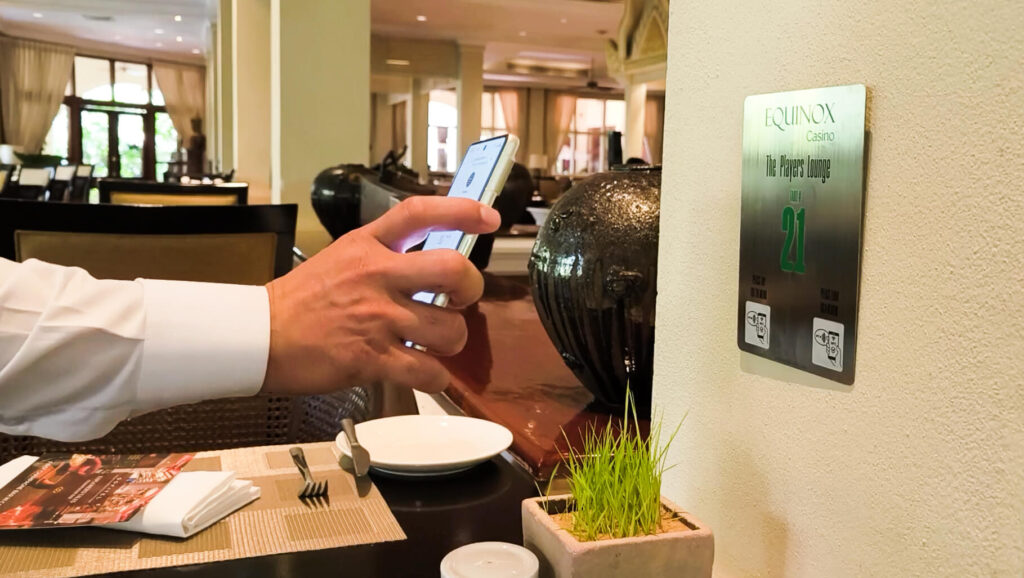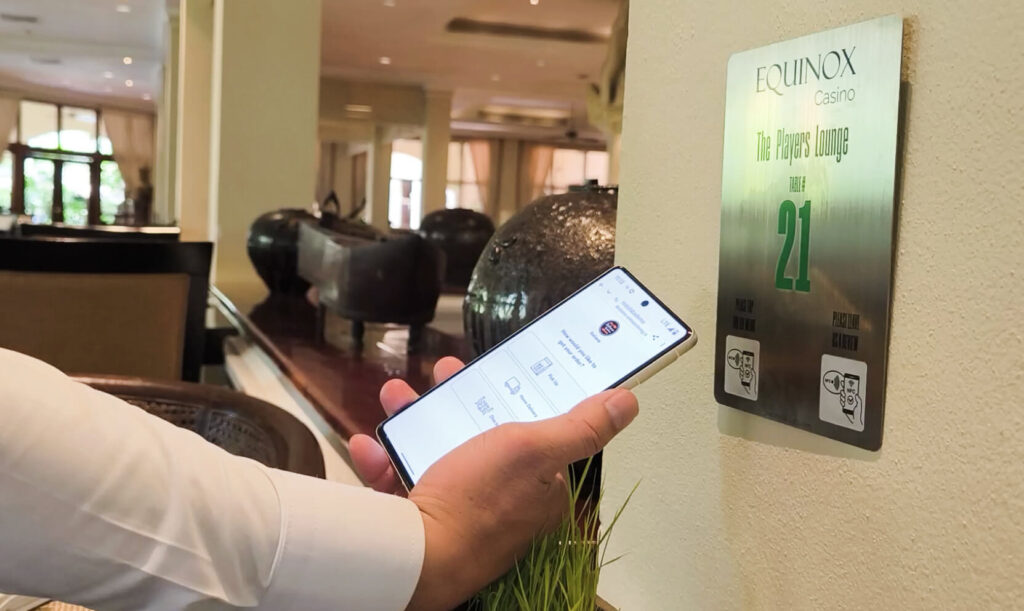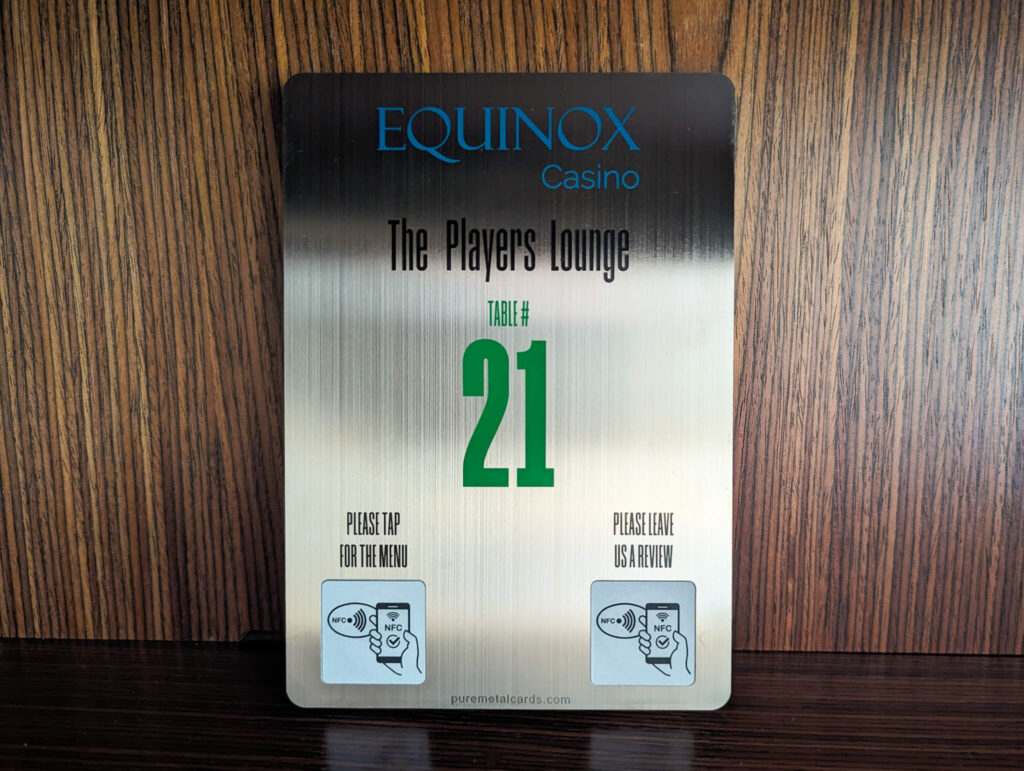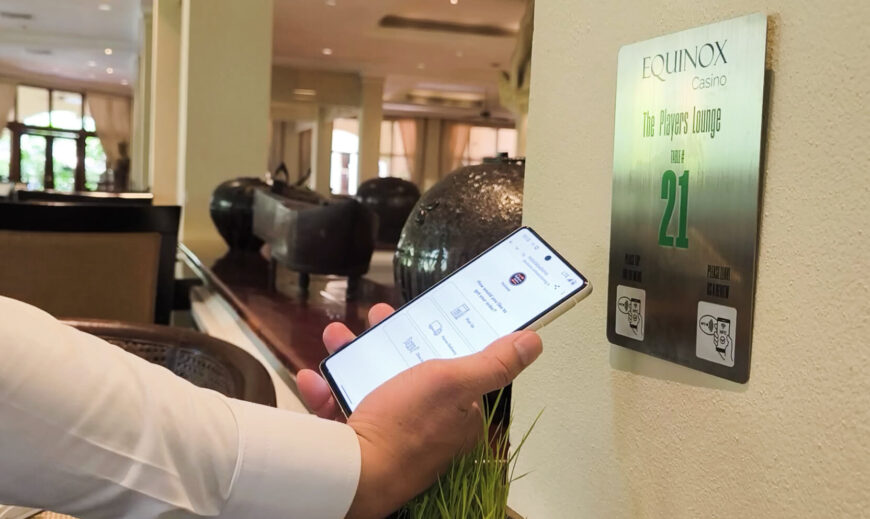In today’s fast-paced world where convenience and efficiency are paramount, the dining experience is undergoing a remarkable transformation. NFC menu cards, leveraging the simplicity of NFC tags and QR codes, are at the forefront of this revolution, offering a seamless, interactive menu experience that far surpasses traditional paper menus. Our Pure Metal Cards metal NFC menu cards will help you revolutionize your dining experience.
These digital menus, which can be effortlessly accessed by simply scanning an NFC tag or sticker, not only enhance operational efficiency but also significantly elevate the customer’s dining journey. By integrating technologies like NFC and digital menu apps, restaurants are not just streamlining their ordering system but are also setting new standards in customer service and engagement.
This article delves into the mechanics of NFC menus, exploring their benefits for restaurants, how they redefine ordering processes, and their role in integrating customer feedback directly through interactive menus. Further sections will outline the practical steps for implementation, share success stories through case studies, and provide valuable tips for maximizing the effectiveness of NFC restaurant menus.
Challenges in deployment and potential solutions will also be examined, offering a comprehensive guide for any restaurant looking to adopt this contactless menu technology. Through an exploration of NFC menus, restaurants can discover how to enhance their offerings, engage with customers on a new level, and ultimately, revolutionize the dining experience.
What Are NFC Menu Cards?
NFC, or Near Field Communication, is a technology that enables two devices, such as a smartphone and a payments terminal, to communicate wirelessly when they are in close proximity, typically a few inches apart. This technology is embedded in modern smartphones and is widely used for mobile payments and data transfer. We offer a summary about using NFC cards here.
Understanding NFC Menu Cards in Restaurants
NFC menu cards utilize this technology to transform traditional restaurant ordering systems into dynamic, digital experiences. By integrating NFC tags or stickers into menu cards, restaurants offer customers a touchless, efficient method to access menus and place orders. Customers can simply tap their NFC-enabled smartphone on a menu card to view the menu and make selections.
Key Features of NFC Menu Cards
- Enhanced Security and Order Maintenance: NFC menu cards help maintain order accuracy and security. Each transaction and order is securely processed and stored in the restaurant’s database, ensuring that orders are accurately tracked and managed.
- Ease of Use: To use NFC menu cards, customers typically need to download a restaurant’s app, where they can view the full menu and place their orders directly from their smartphones.
- Versatility in Design: Restaurants can choose from various shapes when incorporating NFC-enabled items on the menu. These can be strategically placed around the establishment or carried by staff. They offer functionalities such as menu access, Wi-Fi connectivity, and prompts for customer reviews or special offers.
Advantages for Users and Restaurants
Metal NFC menu cards cater to a broad range of technological preferences and significantly reduce the need for physical contact, which has become crucial in post-pandemic dining settings. This system not only enhances the safety and speed of the ordering process but also elevates the overall customer dining experience by providing a seamless, interactive way to explore menu options and place orders.

Benefits of Using NFC Menu Cards in Restaurants
Improved Customer Experience
NFC menu cards significantly enhance the dining experience by providing customers with instant access to digital menus and allowing them to place orders directly from their devices. This convenience not only simplifies the menu access but also personalizes the dining experience with tailored recommendations and dietary information based on customer preferences. Moreover, NFC technology helps in creating a better guest experience by putting customers in control of the ordering process, which increases their satisfaction and engagement.
Streamlined Ordering Process
The integration of NFC menu cards in restaurants streamlines the ordering process by reducing wait times and improving order accuracy. Customers can scan an NFC sticker to initiate ordering on their phone, similar to mobile payment systems like Apple Pay or Google Pay, which minimizes errors in order taking and enhances the efficiency of the service. This system not only facilitates quicker order processing but also allows serving staff to focus more on guest interaction and hospitality, thereby improving the overall service quality.
Enhanced Engagement and Loyalty
NFC menu cards offer interactive menu features that engage customers more deeply by allowing them to explore menu options dynamically, including detailed descriptions and images. Restaurants can integrate loyalty programs with NFC, where customers can tap their cards to earn points, redeem rewards, or receive personalized offers, thus incentivizing repeat visits and building a loyal customer base.
Additionally, NFC-enabled feedback and survey options enhance customer engagement by making it easy for patrons to leave real-time feedback, which restaurants can use to improve their services and tailor their offerings to meet customer expectations.
By leveraging NFC technology, restaurants not only streamline their operations but also create a more engaging, efficient, and personalized dining experience that can lead to increased customer satisfaction and loyalty.

How NFC Menu Cards Work for Ordering
Interaction with Smartphone
NFC technology enables a smooth interaction between the smartphone and the NFC menu card. This process begins when a customer brings their NFC-enabled smartphone close to an NFC sticker or card placed in the restaurant. The NFC technology, which operates without requiring a battery in the NFC object itself, uses the smartphone’s battery to initiate communication. This interaction is akin to using mobile payment systems like Apple Pay or Google Pay, providing a familiar experience to the users.
Menu Browsing and Selection
Once the initial communication is established, the customer can access the digital menu directly on their smartphone. This system offers a dynamic and digital browsing experience where customers can easily navigate through different menu categories, view detailed descriptions, and see prices. The digital menu may also provide additional information such as allergen warnings or nutritional facts, enhancing the customer’s ability to make informed choices.
Customers appreciate the ability to customize their orders according to their preferences, such as selecting specific ingredients or cooking preferences, which can be done without the pressure of quick decision-making or misunderstandings with servers.
Order Placement
After selecting their items, customers can add them to their virtual cart. The digital system may suggest popular or recommended dishes based on the customer’s preferences or past orders, enhancing the personalized dining experience. Once the order is finalized, customers can review it on their device to ensure accuracy before submitting it electronically. The order is then instantly relayed to the kitchen or a dedicated order processing system, streamlining the entire process. This method not only reduces errors but also speeds up the ordering process, allowing the restaurant staff to focus more on customer service rather than order entry.

Integrating Customer Feedback with NFC Menu Cards
Collecting Feedback
NFC technology significantly enhances the feedback collection process in restaurants. By embedding NFC tags in tables or accessible spots, customers can effortlessly initiate feedback mechanisms with a simple tap of their smartphone. This method not only simplifies the process but also encourages immediate responses, capturing customer sentiments while the dining experience is fresh in their minds. Restaurants can link these NFC interactions to review platforms like Google Reviews and TripAdvisor, prompting satisfied customers to share their experiences online, directly from their table. This strategy not only increases the quantity of feedback but also improves its quality, providing restaurants with real-time insights into customer satisfaction.
Analyzing Customer Preferences
The integration of NFC technology extends to analyzing customer preferences effectively. Data collected through NFC interactions offers invaluable insights into customer behavior and preferences. For instance, Ishbilia Restaurant utilized NFC technology to gather feedback which was instrumental in refining their menu and service offerings to better align with customer expectations. By analyzing this feedback, restaurants can identify popular dishes, preferred dining times, and even customer reactions to specific menu changes. This data-driven approach allows for targeted improvements, enhancing customer satisfaction and encouraging repeat visits.
NFC not only streamlines the ordering process but also plays a crucial role in amplifying customer feedback mechanisms, thereby transforming the dining experience into a more efficient, satisfying, and insightful interaction.
Implementation Steps for Restaurants
Choosing the Right NFC Menu Cards
For restaurants eager to embrace NFC technology, the initial step involves selecting the right NFC items tailored to your specific needs—be it table talkers, metal menu cards, or NFC tags for diverse applications like menus, Wi-Fi access, or customer feedback. Contacting a reliable NFC card supplier and choosing the cards that suit your business needs is crucial. Typical menu card dimensions are either 3.37” x 2.12” (86.6 x 54.0mm) or 3.54” x 2.24” (90mm x 57mm). We can create your metal NFC menu cards in stainless steel, brass or copper.
Setting Up the System
Upon choosing your NFC products, integration with your operational systems is crucial. This includes setting up software for tracking interactions and analyzing customer data, which is essential for refining services and enhancing the dining experience. Infrastructure preparation involves planning the placement of NFC cards on your desks and determining the number of card orders. The integration process is usually straightforward, often requiring just the QR menu link for your card supplier to encode the necessary information onto the cards.
Staff Training
The final and critical step is training your staff to ensure they are familiar with the NFC ordering system. This includes explaining the NFC ordering process to guests, assisting customers who need help, and manually placing orders when necessary. It’s important to keep servers educated about your menu to recommend pairings and upsell items effectively. Additionally, when customers place a digital order, it’s an opportune moment to encourage them to download your branded app for a better experience, which also enables push notifications.
By following these steps, restaurants can smoothly implement NFC menu cards, enhancing both operational efficiency and customer satisfaction.
Tips for Effective Use of NFC Menu Cards
Regular Updates
One of the most significant advantages of NFC menu cards is their capability for real-time updates. Restaurants no longer need to reprint menus to change prices or menu items. By simply editing the digital menu, updates are instantaneously reflected, allowing customers to always access the most current offerings. This not only reduces costs associated with printing but also ensures that the menu remains dynamic and adaptable to seasonal ingredients or special promotions.
Promotion and Marketing
NFC menu cards serve as a powerful tool for promotion and marketing. They can transform traditional menus into interactive digital experiences that engage customers more deeply. By tapping their smartphones on NFC-enabled cards, customers can view high-resolution images of dishes, read detailed descriptions, and even watch videos showcasing preparation techniques. This immersive experience not only enhances the dining experience but also aids in making informed decisions about their orders.
Moreover, NFC technology can be integrated into various marketing materials such as posters, flyers, and product packaging. When customers tap their smartphones on these NFC-enabled materials, they can instantly access additional information, promotional offers, or multimedia content. This level of interaction not only boosts engagement but also deepens the customer’s connection with the brand.
Additionally, NFC tags can be placed strategically to capture customer attention during off-peak times or when the physical location is closed. For instance, an NFC tag placed outside the restaurant can redirect customers to the online menu or booking system, ensuring continuous engagement and potential revenue streams even when the restaurant is not physically accessible.
By leveraging NFC technology for regular updates and promotional activities, restaurants can significantly enhance customer satisfaction, streamline their operations, and boost their marketing efforts effectively.
Conclusion
Through the exploration of metal NFC menu cards, we’ve seen their transformative potential in elevating both operational efficiencies and the dining experience. The integration of NFC technology into restaurant ordering systems not only streamlines the process but also opens doors to enhanced customer satisfaction, deeper engagement, and increased loyalty. These technological advancements offer a promising avenue for restaurants aiming to navigate the post-pandemic world, where the demand for convenience, safety, and personalized service is at an all-time high.
The practical benefits to restaurants of adopting such innovations include improved service speed and deeper insights into customer preferences.
As the restaurant industry moves further into the digital age, NFC menu cards stand out as a key tool for restaurants to differentiate themselves in a competitive market. The discussed implementation steps, coupled with the insights from case studies, provide a comprehensive roadmap for any restaurant looking to embrace this technology. While challenges in adoption exist, the benefits—ranging from operational efficiency to customer engagement—are compelling. Restaurants that effectively navigate these waters can look forward to not just surviving but thriving, by offering an enhanced, interactive, and safer dining experience that meets the evolving expectations of today’s tech-savvy consumers.
Upgrade to metal NFC menus, digital business cards or membership cards. At Pure Metal Cards, we have the resources required to help launch and improve your customer retention programs. We are excited to help you create custom metal card designs that will help your business stand out in the crowd. Taking advantage of this amazing tool is as easy as clicking the link below.
FAQs
- What advantages do electronic menus offer in restaurants?Electronic menus, particularly QR digital menus, eliminate the need for physical menus, thereby reducing touchpoints and the risk of transmitting germs. Customers can conveniently access the menu by scanning a QR code with their smartphones, enhancing both safety and satisfaction.
- How can a digital menu app enhance your restaurant’s operations?Digital menu apps allow customers to browse menu options, place orders, and make payments directly through the app. This streamlines the dining experience by reducing wait times and minimizing errors in order transcription, ultimately adding significant value to your restaurant business.
- Why is the menu card crucial in restaurant operations?The menu card is vital as it significantly affects customers’ perceptions, choices, and overall dining satisfaction. A well-designed menu card acts as an effective marketing tool, guiding customers towards more profitable menu items and contributing to the restaurant’s success.

